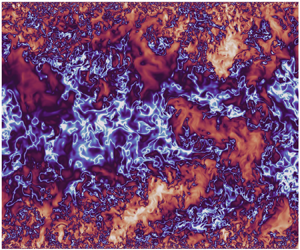Crossref Citations
This article has been cited by the following publications. This list is generated based on data provided by
Crossref.
Deshpande, Rahul
de Silva, Charitha M.
Lee, Myoungkyu
Monty, Jason P.
and
Marusic, Ivan
2021.
Data-driven enhancement of coherent structure-based models for predicting instantaneous wall turbulence.
International Journal of Heat and Fluid Flow,
Vol. 92,
Issue. ,
p.
108879.
Gupta, Vikrant
Madhusudanan, Anagha
Wan, Minping
Illingworth, Simon J.
and
Juniper, Matthew P.
2021.
Linear-model-based estimation in wall turbulence: improved stochastic forcing and eddy viscosity terms.
Journal of Fluid Mechanics,
Vol. 925,
Issue. ,
Skouloudis, Nikolaos
and
Hwang, Yongyun
2021.
Scaling of turbulence intensities up to
Reτ=106
with a resolvent-based quasilinear approximation.
Physical Review Fluids,
Vol. 6,
Issue. 3,
Ruby, Marius
and
Foysi, Holger
2022.
Active control of compressible channel flow up to Mab=3 using direct numerical simulations with spanwise velocity modulation at the walls.
GAMM-Mitteilungen,
Vol. 45,
Issue. 1,
Hernández, Carlos G.
Yang, Qiang
and
Hwang, Yongyun
2022.
Generalised quasilinear approximations of turbulent channel flow. Part 1. Streamwise nonlinear energy transfer.
Journal of Fluid Mechanics,
Vol. 936,
Issue. ,
Doohan, Patrick
Bengana, Yacine
Yang, Qiang
Willis, Ashley P.
and
Hwang, Yongyun
2022.
The state space and travelling-wave solutions in two-scale wall-bounded turbulence.
Journal of Fluid Mechanics,
Vol. 947,
Issue. ,
Hwang, Yongyun
Hutchins, Nicholas
and
Marusic, Ivan
2022.
The logarithmic variance of streamwise velocity and conundrum in wall turbulence.
Journal of Fluid Mechanics,
Vol. 933,
Issue. ,
Wang, Longwei
Pan, Chong
Wang, Jinjun
and
Gao, Qi
2022.
Statistical signatures of component wall-attached eddies in proper orthogonal decomposition modes of a turbulent boundary layer.
Journal of Fluid Mechanics,
Vol. 944,
Issue. ,
Hernández, Carlos G.
Yang, Qiang
and
Hwang, Yongyun
2022.
Generalised quasilinear approximations of turbulent channel flow. Part 2. Spanwise triadic scale interactions.
Journal of Fluid Mechanics,
Vol. 944,
Issue. ,
Chua Khoo, Zhao
Chan, Chi Hin
and
Hwang, Yongyun
2022.
A sparse optimal closure for a reduced-order model of wall-bounded turbulence.
Journal of Fluid Mechanics,
Vol. 939,
Issue. ,
Holford, Jacob J.
Lee, Myoungkyu
and
Hwang, Yongyun
2023.
Optimal white-noise stochastic forcing for linear models of turbulent channel flow.
Journal of Fluid Mechanics,
Vol. 961,
Issue. ,
Hwang, Yongyun
2024.
Near-wall streamwise turbulence intensity as
Reτ→∞.
Physical Review Fluids,
Vol. 9,
Issue. 4,

 $y$, in the present study we analytically demonstrate that the mean velocity is a logarithmic function of
$y$, in the present study we analytically demonstrate that the mean velocity is a logarithmic function of  $y$ if and only if the energy balance at the integral length scale is self-similar with respect to
$y$ if and only if the energy balance at the integral length scale is self-similar with respect to  $y$, providing a theoretical basis for the attached eddy hypothesis. The analysis is subsequently verified with the data from a direct numerical simulation of incompressible channel flow at the friction Reynolds number
$y$, providing a theoretical basis for the attached eddy hypothesis. The analysis is subsequently verified with the data from a direct numerical simulation of incompressible channel flow at the friction Reynolds number  $Re_\tau \simeq 5200$ (Lee & Moser, J. Fluid Mech., vol. 774, 2015, pp. 395–415).
$Re_\tau \simeq 5200$ (Lee & Moser, J. Fluid Mech., vol. 774, 2015, pp. 395–415).